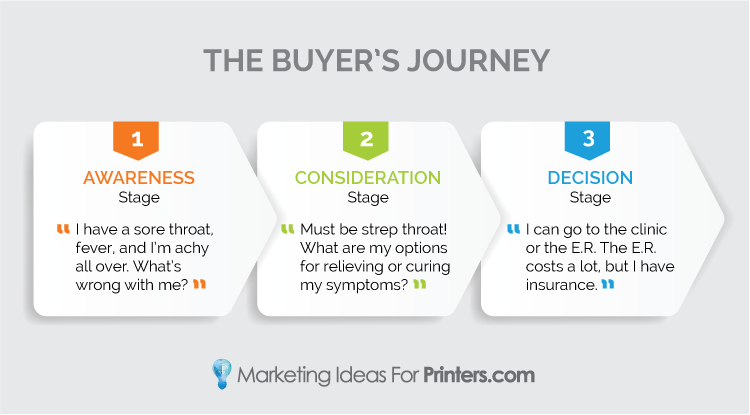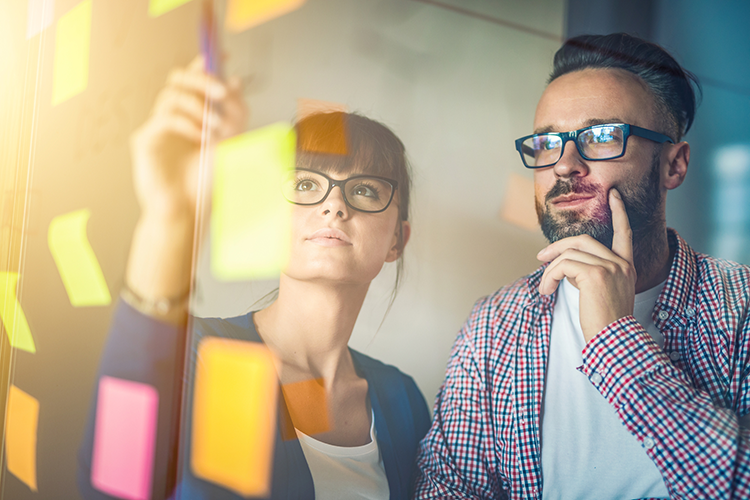Most companies, printers included, haven’t spent the time to define their sales process or the stages a prospect goes through before they buy. Even still, there are several more companies who have discrepancies in their sales process depending who you ask.
Defining this process isn’t an easy exercise to go through, but it’s very necessary. And, having it well-defined will help you grow, follow up with sales opportunities, and streamline your sales process.
But, what does that have to do with MQLs and SQLs?
MQL VS SQL
An MQL is defined as a Marketing Qualified Lead.
It’s a print buyer who’s still a prospect but has indicated a level of interest in buying some sort of printing or services from your print business. This person is deemed likely to become a future customer after some nurturing.
An SQL is defined as a Sales Qualified Lead.
An SQL is a print buyer who started as a prospect and has shown high levels of interest in buying printing from you. They’ve shown that interest through a set of specific actions and are highly likely to then convert into a paying customer. This is someone who’s ready to speak to you about something to purchase.
Quantity Vs. Quality
These definitions boil down to the age-old struggle of quantity vs. quality.
Marketing wants to give the Sales Team a large number (quantity) of leads because it shows they are doing a great job of digging up new prospects, and Sales always want more prospects, but only ones who are ready to buy (quality).
The goal in defining these two aspects of your sales process is to understand the goal: a prospect must become “qualified” and eventually move to a quality, “sales ready” lead.
Tracking and Interpreting
Your leads are going through a natural sales progression of their own before they even make the decision to buy printing or other services from you.
Typically, that means prospects are going through roughly 70% or more of the buying cycle before they’re ready to talk with someone in sales from your business.
So, how do you know what part of the cycle they’re in?
Tracking behaviors such as email open rates or click-through rates in an email campaign can be the first sign of a digital footprint, but it’s a long and winding path. Other behaviors like monitoring page views are great, but remember, even though your team may understand that page views (especially those of a certain length of time) show interest, they might not understand how the difference in page view types affects interest levels. For example, what’s an indicator of more interest? A blog page view or a pricing page view?
Taking that thought further, filling out a form demonstrates an even higher level of interest, but then what? What sort of content are you sending your prospects (MQLs) who are at this stage, and how do you account for the difference between a form submission to download a best-practices white paper and a form submitted to request a quote for a print job of 5,000 pieces for a real estate company?
Tracking and interpreting these MQLs and SQLs goes hand in hand.
Defining Your Funnel
Establishing a lead scoring process allows your organization to quickly translate these behaviors and bridges the gap between your sales and marketing teams to create a powerful alignment.
The goal in this alignment is to define your sales funnel and what actions should be taken at each stage of your buyer’s journey before they order from you.
A buyer’s journey might look like this:

Your Marketing Team needs a clear picture of when a prospect goes from an email response to then becoming an MQL that needs a higher level of tailored content that will move them down the stages of the sales funnel.
The Sales Team must then clearly communicate the actions that take an MQL across the great divide to become an SQL. At the same time, though, remember that those prospects that get thrown back over the divide because they aren’t sales ready quite yet will still provide great insights you can learn from for bettering your process.
Here’s an example of what a sales funnel might look like for your print business:

When examining and creating your sales funnel, you should be able to answer the following types of questions:
- What are your signals that a prospect is becoming a “qualified” lead?
- At what stage does a prospect demonstrate enough interest to be considered an MQL?
- Once a lead has been defined as an MQL, are there any actions that marketing should take at this stage?
- Should the content the Marketing Team delivers be based on a prospect’s stage in the sales funnel?
- At what stage does a prospect become an SQL?
- Once an SQL, how does that lead get passed to the Sales Team?
- What types of alerts and workflows will trigger a follow-up?
- What is the Marketing Team’s ongoing role in the SQL process, if any?
- If a lead is not “sales ready” how does this lead get passed back to marketing?
- How are leads managed (through a CRM) through the sales and marketing process and how is the effectiveness monitored and communicated?
Communication is the Secret Sauce
Creating this process will have growing pains. But, the foundation that makes it effective is that silly little thing called communication.
Both sales and marketing must define and hold to these common goals, together, as a team and be held accountable for their part in the process.
Establishing closed-loop reporting and scheduling regular check-ins for each team to examine the process will constantly improve the effectiveness in producing sale-ready leads and identifying where tweaks need to be made.
Once defined, you can begin applying marketing content to drive engagement and fill your sales funnel to ultimately align your sales and marketing teams for success inside your print business.
So while defining both MQLs and SQLs may seem easy, the process behind each remains a fairly complex operation that requires communication, flexibility, and monitoring.


